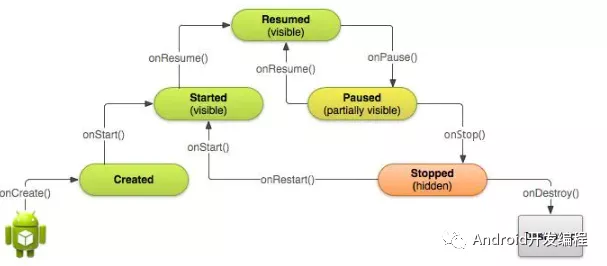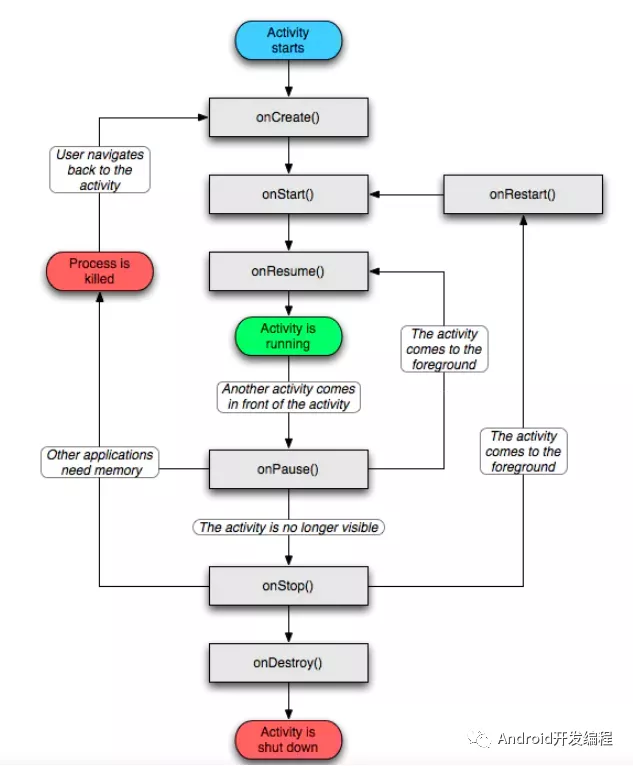前言
Activity是一个很重要、很复杂的组件,他的启动不像我们平时直接new一个对象就完事了,他需要经历一系列的初始化。例如"刚创建状态",“后台状态”,“可见状态”等等;
当我们在界面之间进行切换的时候,activity也会在多种状态之间进行切换,可见或者不可见状态、前台或者后台状态。当Activity在不同的状态之间切换时,会回调不同的生命周期方法;
今天我们就来总结下Activity生命周期;
一、生命周期
Activity个状态生命周期流程图
由上图可知:
1.Starting -> Running,执行的生命周期顺序 onCreate()->onstart()->onResume(),
此activity所处于任务栈的top中,可以与用户进行交互。
2.Running -> Paused ,执行Activity生命周期中的onPause(),
该Activity已失去了焦点但仍然是可见的状态(包括部分可见)。就比如弹出DialogActivity
3.Paused -> Running,执行Activity生命周期中的onResume(),
此情况用户操作[home键],然后重新回到当前activity界面,还有就是关闭DialogActivity
1.Activity1 跳转至 Activity2 执行的生命周期:
- Activity1:onPause
- Activity2:onCreate
- Activity2:onStart
- Activity2:onResume
- Activity1:onStop
2.Activity2回到Activity1 执行的生命周期:
- Activity2:onPause
- Activity1:onRestart
- Activity1:onStart
- Activity1:onResume
- Activity2:onStop
- Activity2:onDestory
3. LifeCycleActivity弹出DialogActivity 执行的生命周期:
- LifeCycleActivity:onPause
- DialogActivity:onCreate
- DialogActivity:onStart
- DialogActivity:onResume
- 值得注意的是:这里 LifeCycleActivity不会进入onStop,因为弹出DialogActivity时LifeCycleActivity还处于可见
4.DialogActivity返回键到LifeCycleActivity执行的生命周期:
- DialogActivity:onPause
- LifeCycleActivity:onResume
- DialogActivity:onStop
- DialogActivity:onDestroy
5.LifeCycleActivity旋转屏幕执行的生命周期:
- LifeCycleActivity:onPause
- LifeCycleActivity:onStop
- LifeCycleActivity:onDestroy
- LifeCycleActivity:onCreate
- LifeCycleActivity:onStart
- LifeCycleActivity:onResume
- 这里相当于重新创建了Activity
6.Activity横竖屏切换状态保存:
当前ViewPager有三个Fragment,在竖屏时选择的Fragment为第二个,如何在切换横屏后选中第二个Fragment并且Fragment保持之前的状态?
由于onCreate可以拿到保持状态的Bundle,而每次onPause以及onStop都会回调onSaveInstanceState(Bundle outState)方法;
所以可在该方法就行保存状态,大体代码如下:
- @Override
- protected void onCreate(Bundle savedInstanceState) {
- super.onCreate(savedInstanceState);
- setContentView(R.layout.activity_main);
- // 初始化主页fragment
- if (savedInstanceState != null) {
- //系统回收后重新进入当前页面恢复数据
- resumeFragment(getSupportFragmentManager(), savedInstanceState);
- resumeIndex(savedInstanceState);
- showSelectFragmentOnly(getSupportFragmentManager());
- mTabLayout.setCurrentItem(mIndex);
- } else {
- //正常初始化
- mTabLayout.setCurrentItem(0);
- showFragment(getSupportFragmentManager(), 0);
- mIndex=0;
- }
- }
- private void resumeFragment(FragmentManager fragmentManager, Bundle savedInstanceState) {
- Fragment[] fragments = new Fragment[fragmentTab.length];
- for (int i = 0; i < fragments.length; i++) {
- fragments[i] = fragmentManager.getFragment(savedInstanceState, fragmentTab[i].getSimpleName());
- }
- mFragments = fragments;
- }
- private void resumeIndex(Bundle savedInstanceState) {
- mIndex = savedInstanceState.getInt(CURRENT_INDEX, 0);
- }
- @Override
- protected void onSaveInstanceState(Bundle outState) {
- super.onSaveInstanceState(outState);
- for (Fragment fragment : mFragments) {
- if (fragment != null) {
- getSupportFragmentManager().putFragment(outState, fragment.getClass().getName(), fragment);
- }
- }
- outState.putInt(CURRENT_INDEX, mIndex);
- }
下图概括了android生命周期的各个环节,描述了activity从生成到销毁的过程
- 创建:onCreate():
- |---可用于初始化工作,如setContentView界面资源、初始化数据
- 启动:onStart():
- |---可见但无法交互
- 恢复:onResume():
- |---恢复播放动画、音乐、视频等
- 暂停:onPause():
- |---可做数据存储、停止动画、音乐、视频等
- 停止:onStop():
- |---此时Activity不可见,可做视情况做些重量级回收工作,避免被Killed
- 销毁:onDestroy():
- |---回收工作、资源释放
- 重现:onRestart():
- |---可做一些恢复工作
二、Activity基本结构
- 一个应用程序通常由多个Activity组成,那么在应用程序中肯定需要一个容器来盛放这些Activity,必要时通过该容器找到对应的Activity,并进行相关操作。上一篇文章已经讲过一个应用程序对应一个ActivityThread,所以自然而然地该容器是ActivityThread在负责维护,这个容器叫做mActivities,是一个数组,里面的每一项叫做ActivityRecord,一个ActivityRecord对应一个Activity。
- 以上仅仅是应用级别的管理容器,但是很多场景下,系统需要找到某一个特定的Activity,并下发相关数据比如事件分发。所以还必须在系统层面再维护一个容器,这个容器存放在Activity Manager Service,对应的容器叫做mHistory,对应的每一项叫做HistroyRecord。
- 每个Activity必须依靠在进程中,每个进程对应一个AMS中的ProcessRecord,通过这个ProcessRecord可以找到对应的应用的所有Activity,同时还提供了与Activity联系的接口IActivityThread。
- 所以整个Activity的管理框架如下图所示:
三.生命周期源码详解
在Launch Activity时,AMS将对应的HistoryRecord作为token传递到客服端和客服端的Activity建立联系。在AMS中Activity状态变化时,将通过该联系找到客服端的Activity,从而将消息或者动作传递应用程序面对的接口:xxxActivity。整个Activity的启动过程大致可以分为以下几个步骤:
发起startActivity(intent)请求
AMS接收到请求后,创建一个HistroyRecord对象,并将该对象放到mHistory数组中
调用app.thread.scheduleLaunchActivity()
AMS创建ActivityRecord对象,将创建的Activity放入到ActivityRecord,再将其放入到mActivities
发起Activity的onCreate()方法
1、Activty是如何创建?ActivityThread 便是这关键
- public final class ActivityThread {
- Instrumentation mInstrumentation;
- ......
- final ApplicationThread mAppThread = new ApplicationThread();
- // Looper类创建
- final Looper mLooper = Looper.myLooper();
- // H是继承Handler类 在AcivityThread创建时就创建了
- final H mH = new H();
- ......
- }
H类源码如下:
- private class H extends Handler {
- ........
- public void handleMessage(Message msg) {
- if (DEBUG_MESSAGES) Slog.v(TAG, ">>> handling: " + codeToString(msg.what));
- switch (msg.what) {
- case LAUNCH_ACTIVITY: {
- Trace.traceBegin(Trace.TRACE_TAG_ACTIVITY_MANAGER, "activityStart");
- final ActivityClientRecord r = (ActivityClientRecord) msg.obj;
- r.packageInfo = getPackageInfoNoCheck(
- r.activityInfo.applicationInfo, r.compatInfo);
- handleLaunchActivity(r, null, "LAUNCH_ACTIVITY");
- Trace.traceEnd(Trace.TRACE_TAG_ACTIVITY_MANAGER);
- } break;
- case RELAUNCH_ACTIVITY: {
- Trace.traceBegin(Trace.TRACE_TAG_ACTIVITY_MANAGER, "activityRestart");
- ActivityClientRecord r = (ActivityClientRecord)msg.obj;
- handleRelaunchActivity(r);
- Trace.traceEnd(Trace.TRACE_TAG_ACTIVITY_MANAGER);
- } break;
- case PAUSE_ACTIVITY: {
- Trace.traceBegin(Trace.TRACE_TAG_ACTIVITY_MANAGER, "activityPause");
- SomeArgs args = (SomeArgs) msg.obj;
- handlePauseActivity((IBinder) args.arg1, false,
- (args.argi1 & USER_LEAVING) != 0, args.argi2,
- (args.argi1 & DONT_REPORT) != 0, args.argi3);
- maybeSnapshot();
- Trace.traceEnd(Trace.TRACE_TAG_ACTIVITY_MANAGER);
- } break;
- case PAUSE_ACTIVITY_FINISHING: {
- Trace.traceBegin(Trace.TRACE_TAG_ACTIVITY_MANAGER, "activityPause");
- SomeArgs args = (SomeArgs) msg.obj;
- handlePauseActivity((IBinder) args.arg1, true, (args.argi1 & USER_LEAVING) != 0,
- args.argi2, (args.argi1 & DONT_REPORT) != 0, args.argi3);
- Trace.traceEnd(Trace.TRACE_TAG_ACTIVITY_MANAGER);
- } break;
- case STOP_ACTIVITY_SHOW: {
- Trace.traceBegin(Trace.TRACE_TAG_ACTIVITY_MANAGER, "activityStop");
- SomeArgs args = (SomeArgs) msg.obj;
- handleStopActivity((IBinder) args.arg1, true, args.argi2, args.argi3);
- Trace.traceEnd(Trace.TRACE_TAG_ACTIVITY_MANAGER);
- } break;
- case STOP_ACTIVITY_HIDE: {
- Trace.traceBegin(Trace.TRACE_TAG_ACTIVITY_MANAGER, "activityStop");
- SomeArgs args = (SomeArgs) msg.obj;
- handleStopActivity((IBinder) args.arg1, false, args.argi2, args.argi3);
- Trace.traceEnd(Trace.TRACE_TAG_ACTIVITY_MANAGER);
- } break;
- case SHOW_WINDOW:
- Trace.traceBegin(Trace.TRACE_TAG_ACTIVITY_MANAGER, "activityShowWindow");
- handleWindowVisibility((IBinder)msg.obj, true);
- Trace.traceEnd(Trace.TRACE_TAG_ACTIVITY_MANAGER);
- break;
- case HIDE_WINDOW:
- Trace.traceBegin(Trace.TRACE_TAG_ACTIVITY_MANAGER, "activityHideWindow");
- handleWindowVisibility((IBinder)msg.obj, false);
- Trace.traceEnd(Trace.TRACE_TAG_ACTIVITY_MANAGER);
- break;
- case RESUME_ACTIVITY:
- Trace.traceBegin(Trace.TRACE_TAG_ACTIVITY_MANAGER, "activityResume");
- SomeArgs args = (SomeArgs) msg.obj;
- handleResumeActivity((IBinder) args.arg1, true, args.argi1 != 0, true,
- args.argi3, "RESUME_ACTIVITY");
- Trace.traceEnd(Trace.TRACE_TAG_ACTIVITY_MANAGER);
- break;
- case SEND_RESULT:
- Trace.traceBegin(Trace.TRACE_TAG_ACTIVITY_MANAGER, "activityDeliverResult");
- handleSendResult((ResultData)msg.obj);
- Trace.traceEnd(Trace.TRACE_TAG_ACTIVITY_MANAGER);
- break;
- case DESTROY_ACTIVITY:
- Trace.traceBegin(Trace.TRACE_TAG_ACTIVITY_MANAGER, "activityDestroy");
- handleDestroyActivity((IBinder)msg.obj, msg.arg1 != 0,
- msg.arg2, false);
- Trace.traceEnd(Trace.TRACE_TAG_ACTIVITY_MANAGER);
- break;
- .........
- }
- }
那么H类handleMessage是怎么被调用的呢?其实是通过ApplicationThread的scheduleLaunchActivity来完成的,这里ApplicationThread是ActivtyThread的内部类
ApplicationThread部分源码如下:
- private class ApplicationThread extends IApplicationThread.Stub {
- ........省略......
- public final void schedulePauseActivity(IBinder token, boolean finished,
- boolean userLeaving, int configChanges, boolean dontReport) {
- int seq = getLifecycleSeq();
- if (DEBUG_ORDER) Slog.d(TAG, "pauseActivity " + ActivityThread.this
- + " operation received seq: " + seq);
- sendMessage(
- finished ? H.PAUSE_ACTIVITY_FINISHING : H.PAUSE_ACTIVITY,
- token,
- (userLeaving ? USER_LEAVING : 0) | (dontReport ? DONT_REPORT : 0),
- configChanges,
- seq);
- }
- public final void scheduleStopActivity(IBinder token, boolean showWindow,
- int configChanges) {
- int seq = getLifecycleSeq();
- if (DEBUG_ORDER) Slog.d(TAG, "stopActivity " + ActivityThread.this
- + " operation received seq: " + seq);
- sendMessage(
- showWindow ? H.STOP_ACTIVITY_SHOW : H.STOP_ACTIVITY_HIDE,
- token, 0, configChanges, seq);
- }
- public final void scheduleWindowVisibility(IBinder token, boolean showWindow) {
- sendMessage(
- showWindow ? H.SHOW_WINDOW : H.HIDE_WINDOW,
- token);
- }
- public final void scheduleSleeping(IBinder token, boolean sleeping) {
- sendMessage(H.SLEEPING, token, sleeping ? 1 : 0);
- }
- public final void scheduleResumeActivity(IBinder token, int processState,
- boolean isForward, Bundle resumeArgs) {
- int seq = getLifecycleSeq();
- if (DEBUG_ORDER) Slog.d(TAG, "resumeActivity " + ActivityThread.this
- + " operation received seq: " + seq);
- updateProcessState(processState, false);
- sendMessage(H.RESUME_ACTIVITY, token, isForward ? 1 : 0, 0, seq);
- }
- public final void scheduleSendResult(IBinder token, List<ResultInfo> results) {
- ResultData res = new ResultData();
- res.token = token;
- res.results = results;
- sendMessage(H.SEND_RESULT, res);
- }
- // AMS通过调用此方法启动Activity
- @Override
- public final void scheduleLaunchActivity(Intent intent, IBinder token, int ident,
- ActivityInfo info, Configuration curConfig, Configuration overrideConfig,
- CompatibilityInfo compatInfo, String referrer, IVoiceInteractor voiceInteractor,
- int procState, Bundle state, PersistableBundle persistentState,
- List<ResultInfo> pendingResults, List<ReferrerIntent> pendingNewIntents,
- boolean notResumed, boolean isForward, ProfilerInfo profilerInfo) {
- updateProcessState(procState, false);
- ActivityClientRecord r = new ActivityClientRecord();
- r.token = token;
- r.ident = ident;
- r.intent = intent;
- r.referrer = referrer;
- r.voiceInteractor = voiceInteractor;
- r.activityInfo = info;
- r.compatInfo = compatInfo;
- r.state = state;
- r.persistentState = persistentState;
- r.pendingResults = pendingResults;
- r.pendingIntents = pendingNewIntents;
- r.startsNotResumed = notResumed;
- r.isForward = isForward;
- r.profilerInfo = profilerInfo;
- r.overrideConfig = overrideConfig;
- updatePendingConfiguration(curConfig);
- sendMessage(H.LAUNCH_ACTIVITY, r);
- }
- ........省略......
- }
2、那么ActivtyThread是如何初始化的?
通过主入口函数main方法进行初始化:
- public static void main(String[] args) {
- Trace.traceBegin(Trace.TRACE_TAG_ACTIVITY_MANAGER, "ActivityThreadMain");
- SamplingProfilerIntegration.start();
- CloseGuard.setEnabled(false);
- Environment.initForCurrentUser();
- EventLogger.setReporter(new EventLoggingReporter());
- final File configDir = Environment.getUserConfigDirectory(UserHandle.myUserId());
- TrustedCertificateStore.setDefaultUserDirectory(configDir);
- Process.setArgV0("<pre-initialized>");
- Looper.prepareMainLooper();
- // 初始化ActivityThread
- ActivityThread thread = new ActivityThread();
- thread.attach(false);
- if (sMainThreadHandler == null) {
- sMainThreadHandler = thread.getHandler();
- }
- if (false) {
- Looper.myLooper().setMessageLogging(new
- LogPrinter(Log.DEBUG, "ActivityThread"));
- }
- // End of event ActivityThreadMain.
- Trace.traceEnd(Trace.TRACE_TAG_ACTIVITY_MANAGER);
- Looper.loop();
- throw new RuntimeException("Main thread loop unexpectedly exited");
- }
3、ApplicationThread的scheduleLaunchActivity是如何被调用的?
在上述代码中我们看到ActivtyThread初始化后调用了attach方法
- private void attach(boolean system) {
- sCurrentActivityThread = this;
- mSystemThread = system;
- if (!system) {
- ViewRootImpl.addFirstDrawHandler(new Runnable() {
- @Override
- public void run() {
- ensureJitEnabled();
- }
- });
- android.ddm.DdmHandleAppName.setAppName("<pre-initialized>",
- UserHandle.myUserId());
- RuntimeInit.setApplicationObject(mAppThread.asBinder());
- final IActivityManager mgr = ActivityManager.getService();
- try {
- // 调用scheduleLaunchActivity的关键代码
- mgr.attachApplication(mAppThread);
- } catch (RemoteException ex) {
- throw ex.rethrowFromSystemServer();
- }
- // Watch for getting close to heap limit.
- BinderInternal.addGcWatcher(new Runnable() {
- @Override public void run() {
- if (!mSomeActivitiesChanged) {
- return;
- }
- Runtime runtime = Runtime.getRuntime();
- long dalvikMax = runtime.maxMemory();
- long dalvikUsed = runtime.totalMemory() - runtime.freeMemory();
- if (dalvikUsed > ((3*dalvikMax)/4)) {
- if (DEBUG_MEMORY_TRIM) Slog.d(TAG, "Dalvik max=" + (dalvikMax/1024)
- + " total=" + (runtime.totalMemory()/1024)
- + " used=" + (dalvikUsed/1024));
- mSomeActivitiesChanged = false;
- try {
- mgr.releaseSomeActivities(mAppThread);
- } catch (RemoteException e) {
- throw e.rethrowFromSystemServer();
- }
- }
- }
- });
- } else {
- // 这里是系统服务初始化的,在SystemServer类中main方法进行调用
- android.ddm.DdmHandleAppName.setAppName("system_process",
- UserHandle.myUserId());
- try {
- mInstrumentation = new Instrumentation();
- ContextImpl context = ContextImpl.createAppContext(
- this, getSystemContext().mPackageInfo);
- mInitialApplication = context.mPackageInfo.makeApplication(true, null);
- mInitialApplication.onCreate();
- } catch (Exception e) {
- throw new RuntimeException(
- "Unable to instantiate Application():" + e.toString(), e);
- }
- }
- // add dropbox logging to libcore
- DropBox.setReporter(new DropBoxReporter());
- ViewRootImpl.ConfigChangedCallback configChangedCallback
- = (Configuration globalConfig) -> {
- synchronized (mResourcesManager) {
- // We need to apply this change to the resources immediately, because upon returning
- // the view hierarchy will be informed about it.
- if (mResourcesManager.applyConfigurationToResourcesLocked(globalConfig,
- null /* compat */)) {
- updateLocaleListFromAppContext(mInitialApplication.getApplicationContext(),
- mResourcesManager.getConfiguration().getLocales());
- // This actually changed the resources! Tell everyone about it.
- if (mPendingConfiguration == null
- || mPendingConfiguration.isOtherSeqNewer(globalConfig)) {
- mPendingConfiguration = globalConfig;
- sendMessage(H.CONFIGURATION_CHANGED, globalConfig);
- }
- }
- }
- };
- ViewRootImpl.addConfigCallback(configChangedCallback);
- }
上述代码中IActivityManager是一个接口而他的实现类就是大名鼎鼎的
- ActivityManagerService(AMS),我们来看AMS中对attachApplication的实现:
- @Override
- public final void attachApplication(IApplicationThread thread) {
- // ApplicationThread 实现了IApplicationThread的接口
- synchronized (this) {
- int callingPid = Binder.getCallingPid();
- final long origId = Binder.clearCallingIdentity();
- attachApplicationLocked(thread, callingPid);
- Binder.restoreCallingIdentity(origId);
- }
- }
attachApplicationLocked方法中调用了ActivityStackSupervisor中的attachApplicationLocked方法,而该方法中调用了ApplicationThread中scheduleLaunchActivity,有兴趣的可以去看下源码。
我们可以发现其实不管是scheduleLaunchActivity还是其他的schedule...方法都调用了ApplicationThread中的sendMessage方法,该方法如下:
- private void sendMessage(int what, Object obj) {
- sendMessage(what, obj, 0, 0, false);
- }
- private void sendMessage(int what, Object obj, int arg1) {
- sendMessage(what, obj, arg1, 0, false);
- }
- private void sendMessage(int what, Object obj, int arg1, int arg2) {
- sendMessage(what, obj, arg1, arg2, false);
- }
- private void sendMessage(int what, Object obj, int arg1, int arg2, boolean async) {
- if (DEBUG_MESSAGES) Slog.v(
- TAG, "SCHEDULE " + what + " " + mH.codeToString(what)
- + ": " + arg1 + " / " + obj);
- Message msg = Message.obtain();
- msg.what = what;
- msg.obj = obj;
- msg.arg1 = arg1;
- msg.arg2 = arg2;
- if (async) {
- msg.setAsynchronous(true);
- }
- mH.sendMessage(msg);
- }
我们方法转了一圈依旧回到了handler.sendMessage()方法,可见handler在Android中的重要性;
4、如何处理Handler发送的消息呢?
通过handleMessage进行处理,所有的生命周期其实都是通过该方法处理的,源码如下:
- public void handleMessage(Message msg) {
- ......省略.....
- if (DEBUG_MESSAGES) Slog.v(TAG, ">>> handling: " + codeToString(msg.what));
- switch (msg.what) {
- case LAUNCH_ACTIVITY: {
- Trace.traceBegin(Trace.TRACE_TAG_ACTIVITY_MANAGER, "activityStart");
- final ActivityClientRecord r = (ActivityClientRecord) msg.obj;
- r.packageInfo = getPackageInfoNoCheck(
- r.activityInfo.applicationInfo, r.compatInfo);
- handleLaunchActivity(r, null, "LAUNCH_ACTIVITY");
- Trace.traceEnd(Trace.TRACE_TAG_ACTIVITY_MANAGER);
- } break;
- }
- ......省略.....
- }
Looper会循环获取messageQueue队列中的message,并通过dispatchMessage多消息进行分发,源码如下:
- public void dispatchMessage(Message msg) {
- if (msg.callback != null) {
- handleCallback(msg);
- } else {
- if (mCallback != null) {
- if (mCallback.handleMessage(msg)) {
- return;
- }
- }
- / 这里其实是调用了H类的handleMessage方法
- handleMessage(msg);
- }
- }
上述代码可以看到handleMessage中的handleLaunchActivity是关键,handleLaunchActivity代码如下:
- private void handleLaunchActivity(ActivityClientRecord r, Intent customIntent, String reason) {
- unscheduleGcIdler();
- mSomeActivitiesChanged = true;
- if (r.profilerInfo != null) {
- mProfiler.setProfiler(r.profilerInfo);
- mProfiler.startProfiling();
- }
- handleConfigurationChanged(null, null);
- if (localLOGV) Slog.v(
- TAG, "Handling launch of " + r);
- WindowManagerGlobal.initialize();
- // 在这里创建了application以及activity
- Activity a = performLaunchActivity(r, customIntent);
- if (a != null) {
- r.createdConfig = new Configuration(mConfiguration);
- reportSizeConfigurations(r);
- Bundle oldState = r.state;
- handleResumeActivity(r.token, false, r.isForward,
- !r.activity.mFinished && !r.startsNotResumed, r.lastProcessedSeq, reason);
- if (!r.activity.mFinished && r.startsNotResumed) {
- performPauseActivityIfNeeded(r, reason);
- if (r.isPreHoneycomb()) {
- r.state = oldState;
- }
- }
- } else {
- try {
- ActivityManager.getService()
- .finishActivity(r.token, Activity.RESULT_CANCELED, null,
- Activity.DONT_FINISH_TASK_WITH_ACTIVITY);
- } catch (RemoteException ex) {
- throw ex.rethrowFromSystemServer();
- }
- }
- }
- private Activity performLaunchActivity(ActivityClientRecord r, Intent customIntent) {
- // System.out.println("##### [" + System.currentTimeMillis() + "] ActivityThread.performLaunchActivity(" + r + ")");
- ActivityInfo aInfo = r.activityInfo;
- if (r.packageInfo == null) {
- r.packageInfo = getPackageInfo(aInfo.applicationInfo, r.compatInfo,
- Context.CONTEXT_INCLUDE_CODE);
- }
- ComponentName component = r.intent.getComponent();
- if (component == null) {
- component = r.intent.resolveActivity(
- mInitialApplication.getPackageManager());
- r.intent.setComponent(component);
- }
- if (r.activityInfo.targetActivity != null) {
- component = new ComponentName(r.activityInfo.packageName,
- r.activityInfo.targetActivity);
- }
- // 创建context
- ContextImpl appContext = createBaseContextForActivity(r);
- Activity activity = null;
- try {
- java.lang.ClassLoader cl = appContext.getClassLoader();
- // activty的创建
- activity = mInstrumentation.newActivity(
- cl, component.getClassName(), r.intent);
- StrictMode.incrementExpectedActivityCount(activity.getClass());
- r.intent.setExtrasClassLoader(cl);
- r.intent.prepareToEnterProcess();
- if (r.state != null) {
- r.state.setClassLoader(cl);
- }
- } catch (Exception e) {
- if (!mInstrumentation.onException(activity, e)) {
- throw new RuntimeException(
- "Unable to instantiate activity " + component
- + ": " + e.toString(), e);
- }
- }
- try {
- // application的创建
- Application app = r.packageInfo.makeApplication(false, mInstrumentation);
- if (localLOGV) Slog.v(TAG, "Performing launch of " + r);
- if (localLOGV) Slog.v(
- TAG, r + ": app=" + app
- + ", appName=" + app.getPackageName()
- + ", pkg=" + r.packageInfo.getPackageName()
- + ", comp=" + r.intent.getComponent().toShortString()
- + ", dir=" + r.packageInfo.getAppDir());
- if (activity != null) {
- // 从配置文件获取label作为Activity默认title
- CharSequence title = r.activityInfo.loadLabel(appContext.getPackageManager());
- Configuration config = new Configuration(mCompatConfiguration);
- if (r.overrideConfig != null) {
- config.updateFrom(r.overrideConfig);
- }
- if (DEBUG_CONFIGURATION) Slog.v(TAG, "Launching activity "
- + r.activityInfo.name + " with config " + config);
- // window的创建
- Window window = null;
- if (r.mPendingRemoveWindow != null && r.mPreserveWindow) {
- window = r.mPendingRemoveWindow;
- r.mPendingRemoveWindow = null;
- r.mPendingRemoveWindowManager = null;
- }
- appContext.setOuterContext(activity);
- activity.attach(appContext, this, getInstrumentation(), r.token,
- r.ident, app, r.intent, r.activityInfo, title, r.parent,
- r.embeddedID, r.lastNonConfigurationInstances, config,
- r.referrer, r.voiceInteractor, window, r.configCallback);
- if (customIntent != null) {
- activity.mIntent = customIntent;
- }
- r.lastNonConfigurationInstances = null;
- checkAndBlockForNetworkAccess();
- activity.mStartedActivity = false;
- int theme = r.activityInfo.getThemeResource();
- if (theme != 0) {
- activity.setTheme(theme);
- }
- activity.mCalled = false;
- if (r.isPersistable()) {
- // 触发onCreate回调
- mInstrumentation.callActivityOnCreate(activity, r.state, r.persistentState);
- } else {
- // 触发onCreate回调
- mInstrumentation.callActivityOnCreate(activity, r.state);
- }
- if (!activity.mCalled) {
- throw new SuperNotCalledException(
- "Activity " + r.intent.getComponent().toShortString() +
- " did not call through to super.onCreate()");
- }
- r.activity = activity;
- r.stopped = true;
- if (!r.activity.mFinished) {
- activity.performStart();
- r.stopped = false;
- }
- if (!r.activity.mFinished) {
- if (r.isPersistable()) {
- if (r.state != null || r.persistentState != null) {
- mInstrumentation.callActivityOnRestoreInstanceState(activity, r.state,
- r.persistentState);
- }
- } else if (r.state != null) {
- // 其实都是调用了Activity的onPostCreate方法,该方法调用了onTitleChanged方法,用于设置title栏
- mInstrumentation.callActivityOnRestoreInstanceState(activity, r.state);
- }
- }
- if (!r.activity.mFinished) {
- activity.mCalled = false;
- if (r.isPersistable()) {
- mInstrumentation.callActivityOnPostCreate(activity, r.state,
- r.persistentState);
- } else {
- mInstrumentation.callActivityOnPostCreate(activity, r.state);
- }
- if (!activity.mCalled) {
- throw new SuperNotCalledException(
- "Activity " + r.intent.getComponent().toShortString() +
- " did not call through to super.onPostCreate()");
- }
- }
- }
- r.paused = true;
- mActivities.put(r.token, r);
- } catch (SuperNotCalledException e) {
- throw e;
- } catch (Exception e) {
- if (!mInstrumentation.onException(activity, e)) {
- throw new RuntimeException(
- "Unable to start activity " + component
- + ": " + e.toString(), e);
- }
- }
- return activity;
- }
上述代码中可以看到在performLaunchActivity中创建了上下文Context,Application,以及Activity,而后通过Activity的attach方法为Context赋值并且将Activity与Window绑定,有兴趣的可以去看下其实是为ContextWrapper中的mBase对象进行了赋值,而且Activity的attach方法中实例化了Window对象,并且设定了UI线程为当前线程,这里就不做讲解,贴出attach的源码:
- final void attach(Context context, ActivityThread aThread,
- Instrumentation instr, IBinder token, int ident,
- Application application, Intent intent, ActivityInfo info,
- CharSequence title, Activity parent, String id,
- NonConfigurationInstances lastNonConfigurationInstances,
- Configuration config, String referrer, IVoiceInteractor voiceInteractor,
- Window window, ActivityConfigCallback activityConfigCallback) {
- attachBaseContext(context);
- mFragments.attachHost(null /*parent*/);
- mWindow = new PhoneWindow(this, window, activityConfigCallback);
- mWindow.setWindowControllerCallback(this);
- mWindow.setCallback(this);
- mWindow.setOnWindowDismissedCallback(this);
- mWindow.getLayoutInflater().setPrivateFactory(this);
- if (info.softInputMode != WindowManager.LayoutParams.SOFT_INPUT_STATE_UNSPECIFIED) {
- mWindow.setSoftInputMode(info.softInputMode);
- }
- if (info.uiOptions != 0) {
- mWindow.setUiOptions(info.uiOptions);
- }
- mUiThread = Thread.currentThread();
- mMainThread = aThread;
- mInstrumentation = instr;
- mToken = token;
- mIdent = ident;
- mApplication = application;
- mIntent = intent;
- mReferrer = referrer;
- mComponent = intent.getComponent();
- mActivityInfo = info;
- mTitle = title;
- mParent = parent;
- mEmbeddedID = id;
- mLastNonConfigurationInstances = lastNonConfigurationInstances;
- if (voiceInteractor != null) {
- if (lastNonConfigurationInstances != null) {
- mVoiceInteractor = lastNonConfigurationInstances.voiceInteractor;
- } else {
- mVoiceInteractor = new VoiceInteractor(voiceInteractor, this, this,
- Looper.myLooper());
- }
- }
- mWindow.setWindowManager(
- (WindowManager)context.getSystemService(Context.WINDOW_SERVICE),
- mToken, mComponent.flattenToString(),
- (info.flags & ActivityInfo.FLAG_HARDWARE_ACCELERATED) != 0);
- if (mParent != null) {
- mWindow.setContainer(mParent.getWindow());
- }
- mWindowManager = mWindow.getWindowManager();
- mCurrentConfig = config;
- mWindow.setColorMode(info.colorMode);
- }
在所有生命周期回调中,都是调用了Instrumentation中的方法,而Instrumentation的调用都是通过Handler发送消息触发H函数的handleMessage方法来进行的,然后Instrumentation中的方法再去调用Activity中的生命周期方法,其实我们常用的onActivityResult回调都是通过handleMessage去分发的。Instrumentation部分代码如下
- // 触发onCreate
- public void callActivityOnCreate(Activity activity, Bundle icicle,
- PersistableBundle persistentState) {
- prePerformCreate(activity);
- activity.performCreate(icicle, persistentState);
- postPerformCreate(activity);
- }
- // 触发onResume
- public void callActivityOnResume(Activity activity) {
- activity.mResumed = true;
- activity.onResume();
- if (mActivityMonitors != null) {
- synchronized (mSync) {
- final int N = mActivityMonitors.size();
- for (int i=0; i<N; i++) {
- final ActivityMonitor am = mActivityMonitors.get(i);
- am.match(activity, activity, activity.getIntent());
- }
- }
- }
- }
总结:
- 创建一个activity会依次执行onCreate, onStart, onResume
- 从一个activity启动另一个activity会先调用当前activity的onResume,然后在创建并显示要启动的activity。
- 从非透明activity返回的时候会先调用当前的onPause,然后调用前一个activitiy的onRestart、onStart、onResme,然后在调用这个Activity的onStop,onDestroy。
- 从透明的activity返回的时候会先调用当前activity的onPause,然后调用前一个activity的onResume,然后调用这个透明activity的onStop,onDestroy。
- 透明的Activity比较特殊,他会让别的activity的一些生命周期不被调用比如onStop等待。
- onResume方法里不能有太耗时的操作,因为当启动另一个activity的时候,当前的onResume没有返回不会去创建要启动的那个activity
- Activity启动过程会经历两次跨进程,从App进程到AMS,从AMS再到APP进程,实际情况要远比这复杂的多;
本文转载自微信公众号「 Android开发编程 」































